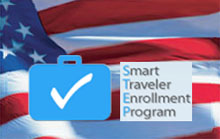American Citizen Services
Radiation, Health and Food Safety Information Post-Fukushima
Last updated September 5, 2013
After the March 11, 2011 earthquake and tsunami damaged the Fukushima Daiichi nuclear power plant, radiation was released into the environment near the plant. Japanese government officials have taken steps to protect public health, including evacuating the area around the plant and stopping production and distribution of food from affected areas to other parts of Japan and the world. Japan has also implemented a broad program of radiation monitoring, centering on Fukushima Prefecture. Regular monitoring of air, food, and water for radiation continues and additional information on these activities is provided below.
Summer 2014: Concern over Fukushima Daiichi Water Leaks Continues
More than three years after the accident, the Fukushima Daiichi nuclear power plant is stable, but still severely damaged. The Tokyo Electric Power Company (TEPCO) is working with Japanese government agencies to address leaks of contaminated water on the site. TEPCO and Japanese government agencies routinely monitor levels of radiation in the seawater near the Fukushima Daiichi nuclear power plant to identify contamination levels. TEPCO provides regular technical updates in English of its efforts and radiation monitoring.
Japanese authorities have not identified any radiation levels, outside of restricted access areas, that increase radiation exposure risks for residents of Japan. Japanese authorities also conduct regular inspections of food and tap water and have not identified any increased radiation levels. For more information on these efforts and to view the latest results, please see the links below.
About radiation exposure or contamination
The U.S. Centers for Disease Control and Prevention and the Environmental Protection Agency (EPA) provide helpful information about radiation and its health effects.
- EPA information on Radiation Doses in Perspective.
- Additional visual presentations of radiation dose from Japan's National Institute of Radiological Sciences.
Food and Water
As in the United States, the Japanese government has set standards for radioactive material in food and beverages to protect public health. Japan's Cabinet Office posted an English summary of Food Safety in Japan following the 2011 nuclear accident. (The pdf can also be found here.)
Radioactivity measurements in food, water, and the environment are collected and updated regularly by Japan's Nuclear Regulation Authority. The Nuclear Regulation Authority divides responsibilities for radiation monitoring with several other agencies, in accordance with its Comprehensive Radiation Monitoring Plan.
Japan's Ministry of Health, Labor and Welfare (MHLW) is responsible for food safety in agricultural, forestry, livestock, and fishery products. MHLW regularly updates its English language website with information on the safety of water and specific foods in Japan.
- Japan's Standards for Radionuclides in Foods (updated 2012)
- Test results for radioactive contaminants in foods (updated daily)
- Fukushima Prefecture searchable site for food test results (updated daily)
- Press releases detailing changes in restricted foods (updated regularly)
MHLW has not restricted tap water intake since May 2011, but tap water is routinely surveyed.
- The results for Fukushima Prefecture are updated regularly.
- The Tokyo Metropolitan Government posts results daily, usually marked ND for not-detectable.
Japan's Fisheries Agency—under the Ministry of Agriculture, Forestry, and Fisheries—works with prefectural governments and local fishery groups to sample and inspect fishery products at major ports in Fukushima Prefecture and nearby prefectures for radioactive contamination on a weekly basis.
- Results of inspections for radioactive materials in fishery products (updated regularly)
More resources
- The Japanese Cabinet Office's Overview page for the Earthquake and Recovery
- Chiba Prefecture's English website for Disaster Prevention
- Ibaraki Prefecture's English website for Emergency and Disaster
- Kanagawa Prefecture's bilingual site for Earthquake Information, including current radiation results.
- Saitama Prefecture's English consultation site.
- Latest report on radiation levels at the Narita and Haneda airports.
- Tokyo Metropolitan Government radiation surveys around the city and at the Port of Tokyo
- The U.S. Department of Defense Operation Tomodachi Registry provides radiation exposure estimates for DOD-affiliated individuals who were in or near Japan immediately after the March 2011 accident. The site also has location-based radiation dose estimates.
- Tokyo Metropolitan Government's website provides hourly radiation levels monitored at eight locations in Tokyo, including Shinjuku, Ota, and Adachi wards, as well as the results of fallout, tap water and food sampling testing conducted by the metro government. The website also provides all the past radiation readings Tokyo has monitored since 2011. In Japanese and English.
The U.S. Nuclear Regulatory Commission (NRC) regulates nuclear material in the United States.
- Radiation dose calculator (for the United States)
- Frequently asked questions about radiation
- Ask an expert about radiation
The U.S. Environmental Protection Agency (EPA) provides general radiation protection guidance to the U.S. federal government and states for use in developing radiation protection rules and regulations to protect the American public from the harmful effects of radiation. Further information about the radioactive isotopes commonly identified at the Fukushima Dai-ichi nuclear power plant can be found here:
World Health Organization
- Preliminary Dose Estimation from the Nuclear Accident (2012)
- Health Risk Assessment from the Nuclear Accident after the 2011 Great East Japan Earthquake and Tsunami (2013)
International Atomic Energy Agency
- The March 2011 nuclear accident was given the most serious classification—a seven—on the International Nuclear and Radiological Event Scale (INES). Subsequent releases of radiation may also be designated on the INES scale. Learn more about the categories here.
- The IAEA and the UN Food and Agriculture Organization provide general guidance on Nuclear Emergency Response for Food and Agriculture.
 Please sign up for travel updates and Embassy Warden Messages!
Please sign up for travel updates and Embassy Warden Messages!
U.S. Experts Discuss Health & Radiation
![]() Videos
Videos
• Ms. Jana Telfer, Centers for Disease Control: Health and Radiation
• Dr. Norm Coleman, National Cancer Institute: Understanding Radiation
• Captain Michael Noska, PhD, U.S. Food and Drug Administration: Food and Water Safety
• Dr. Steve Simon, National Cancer Institute: Radiation Risk